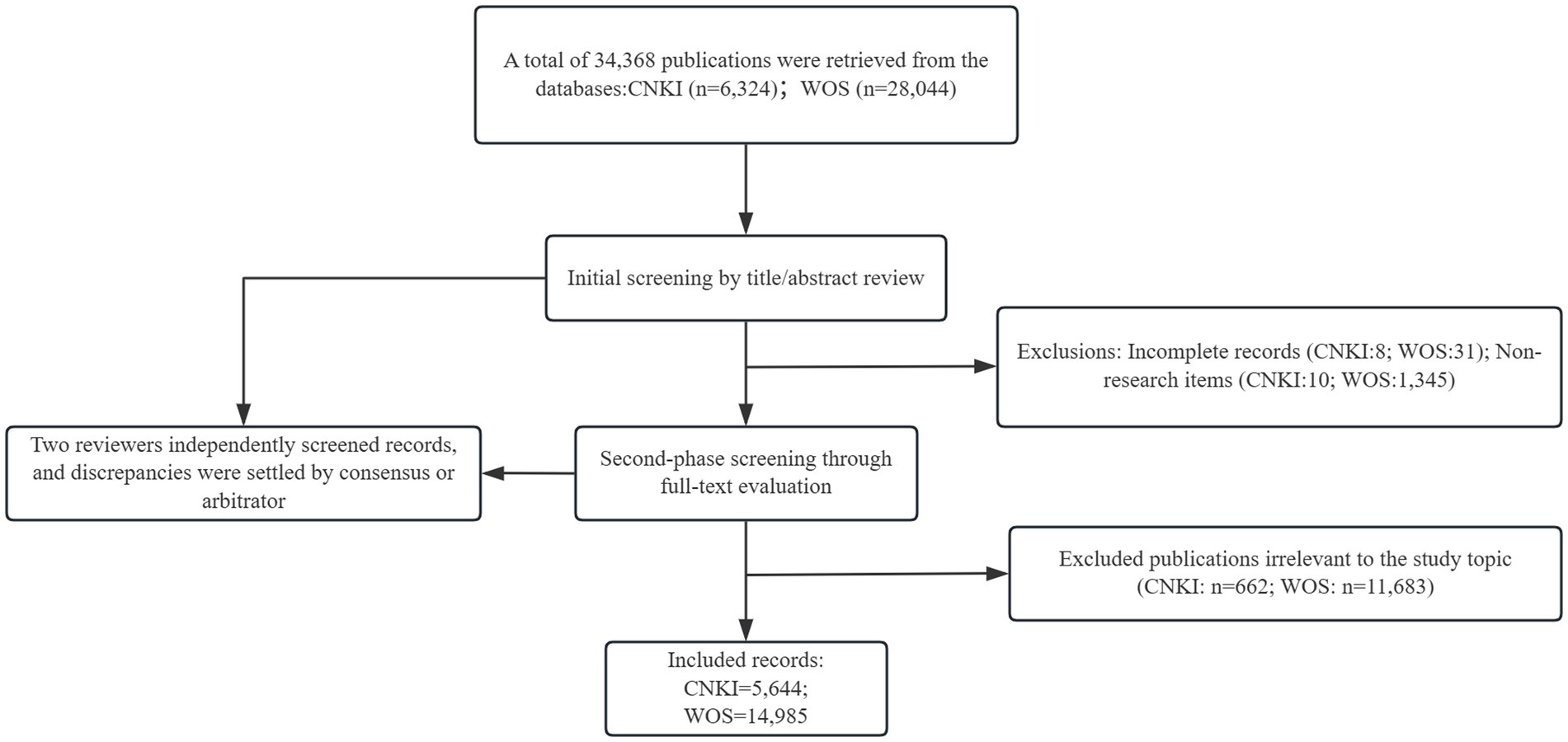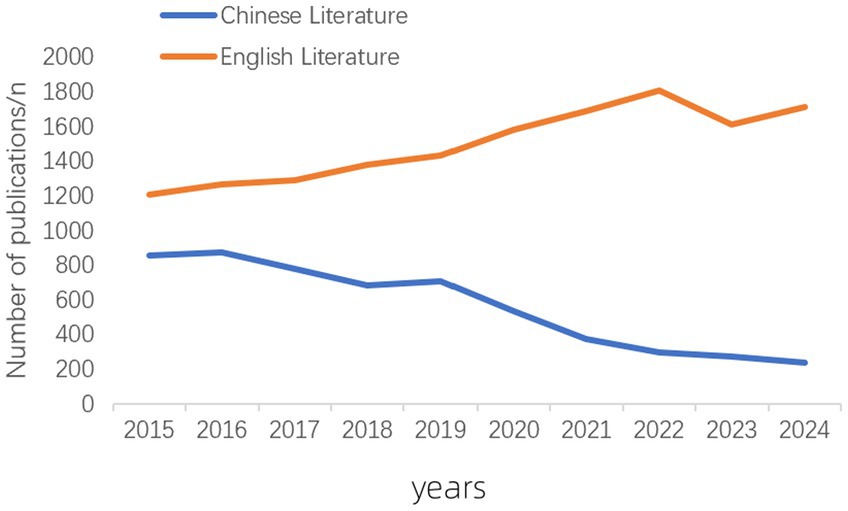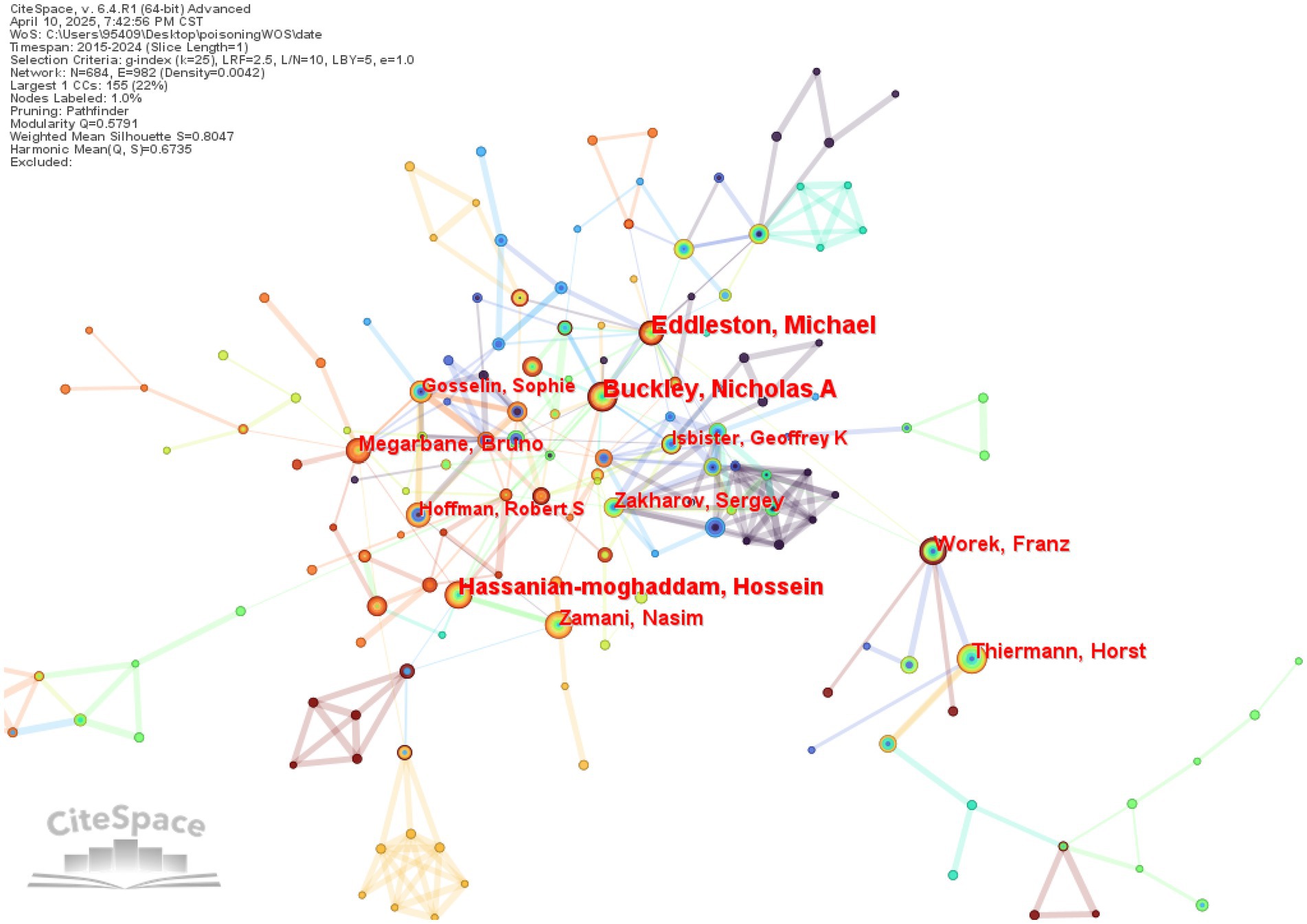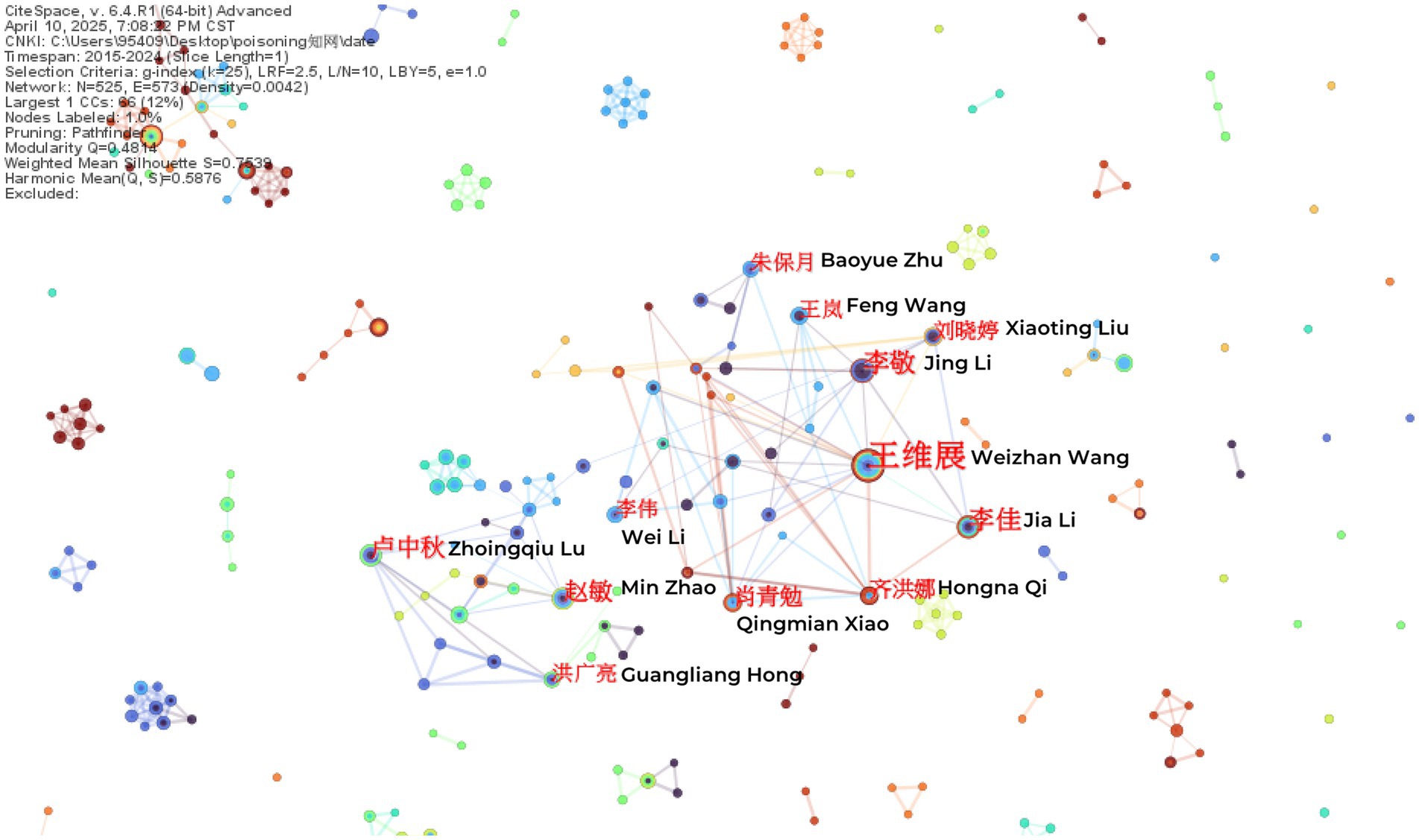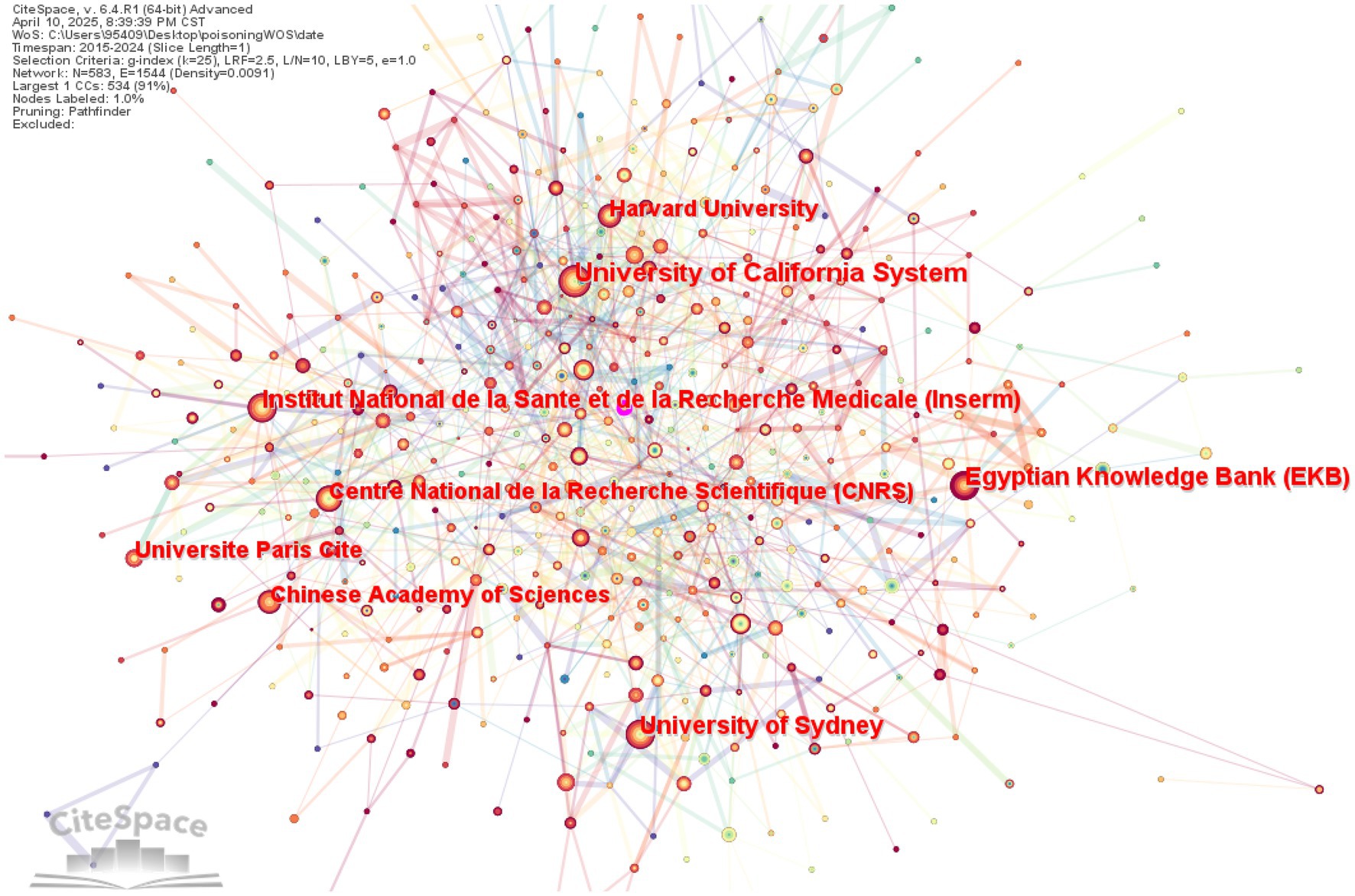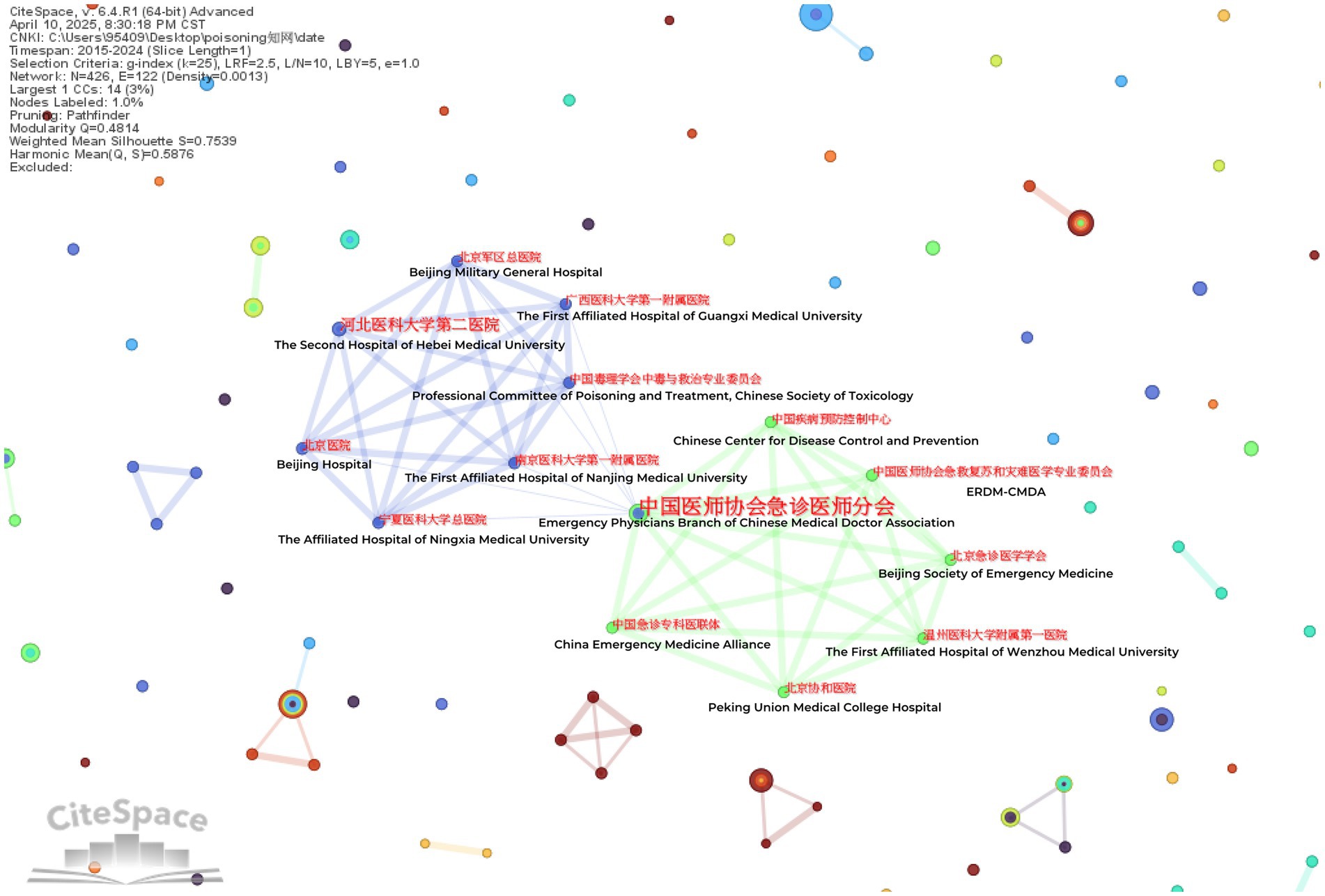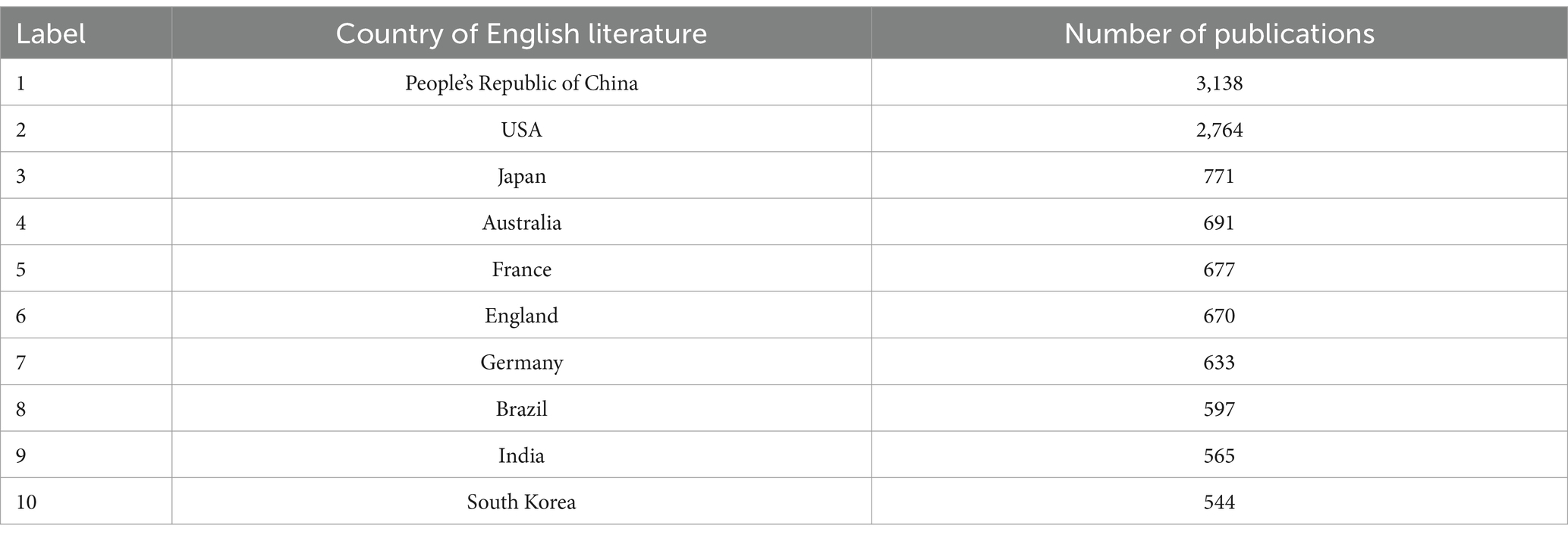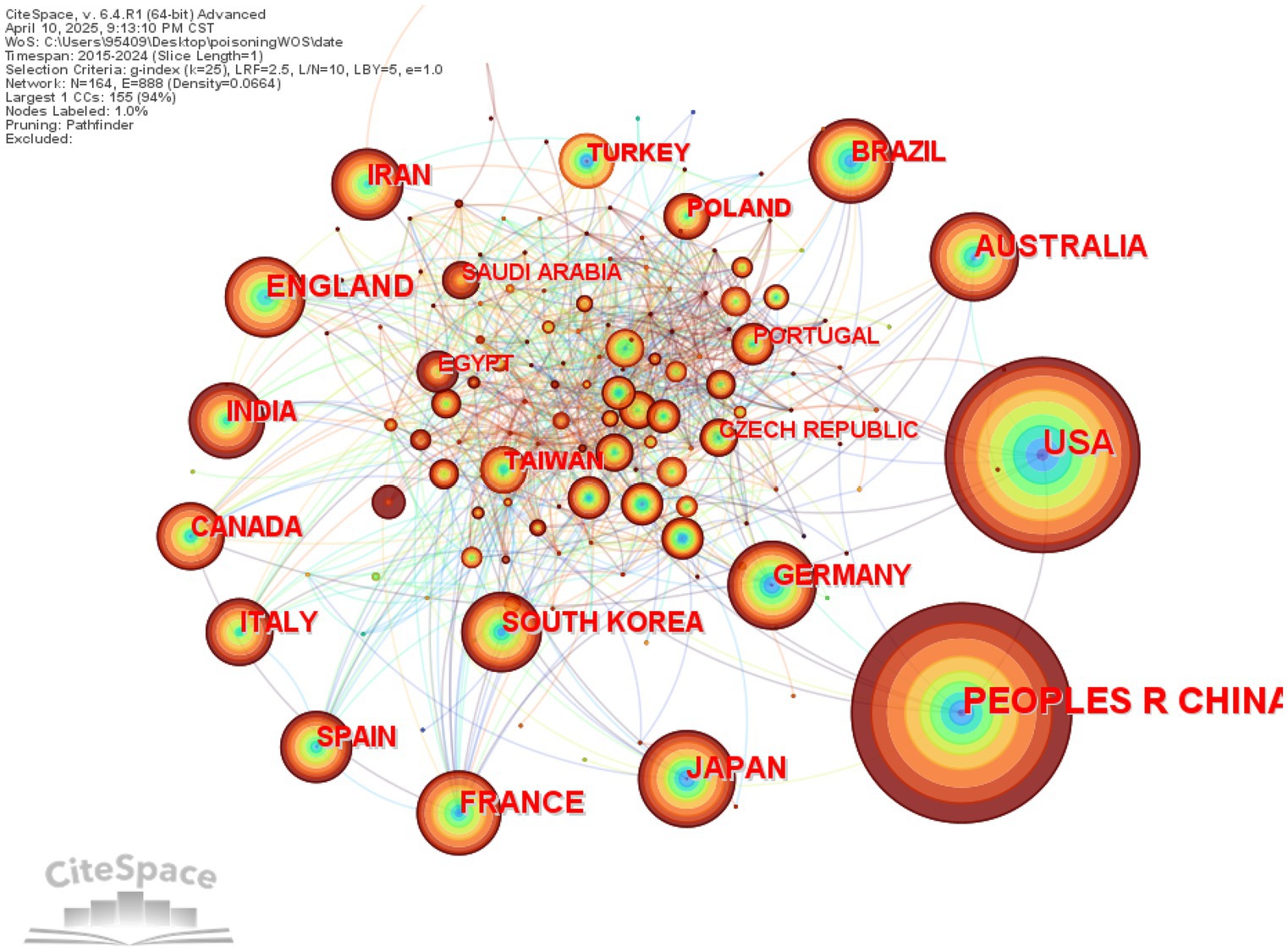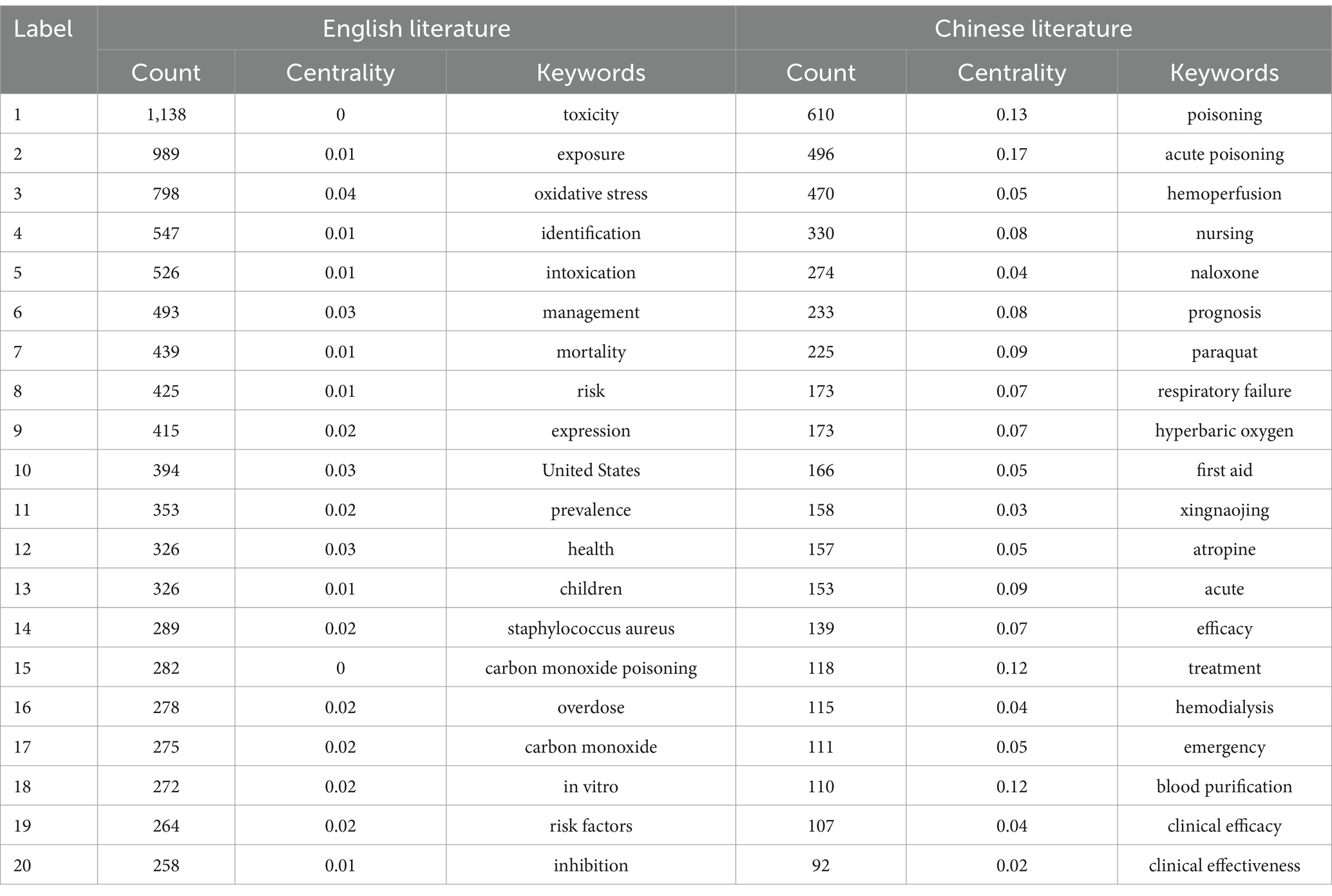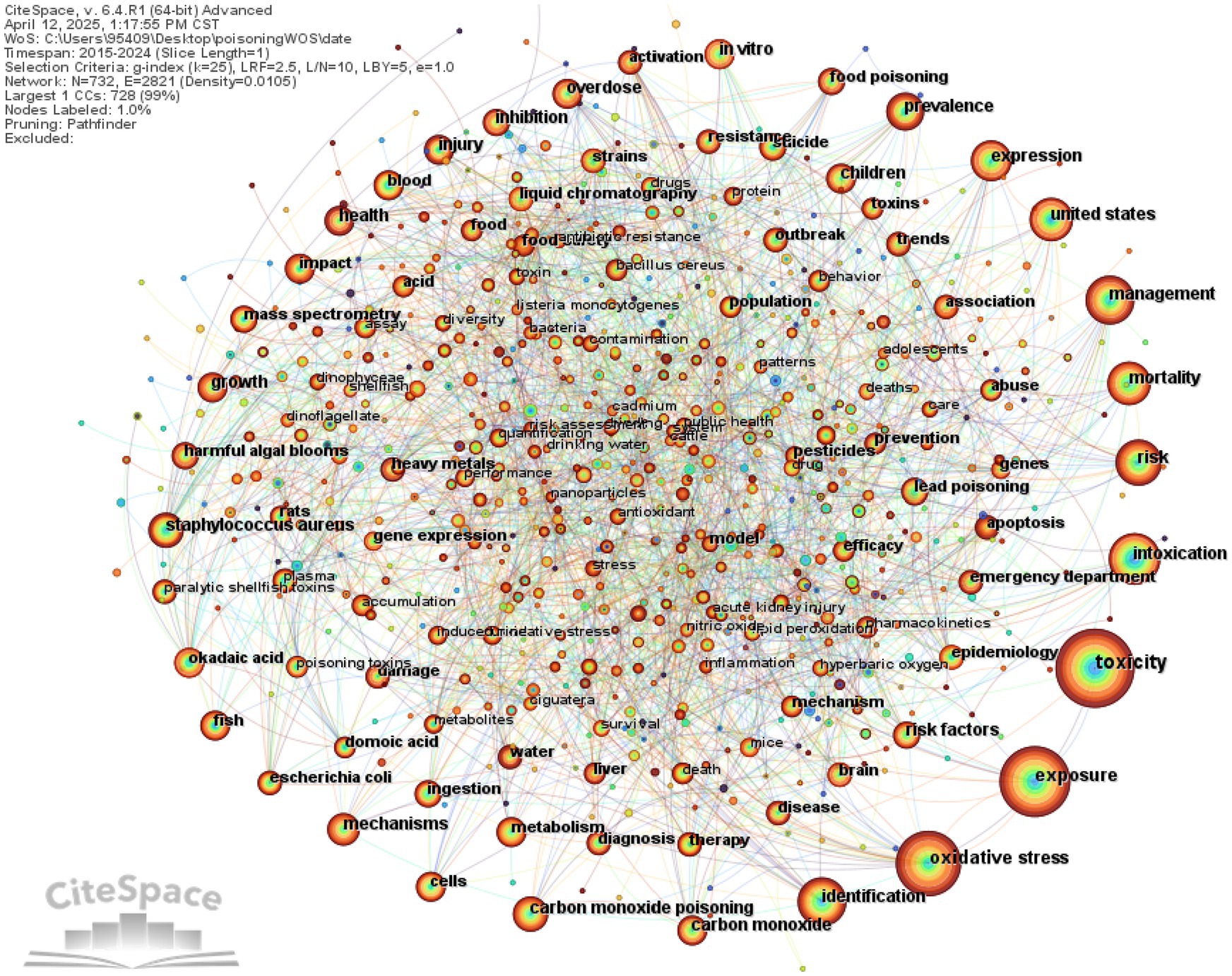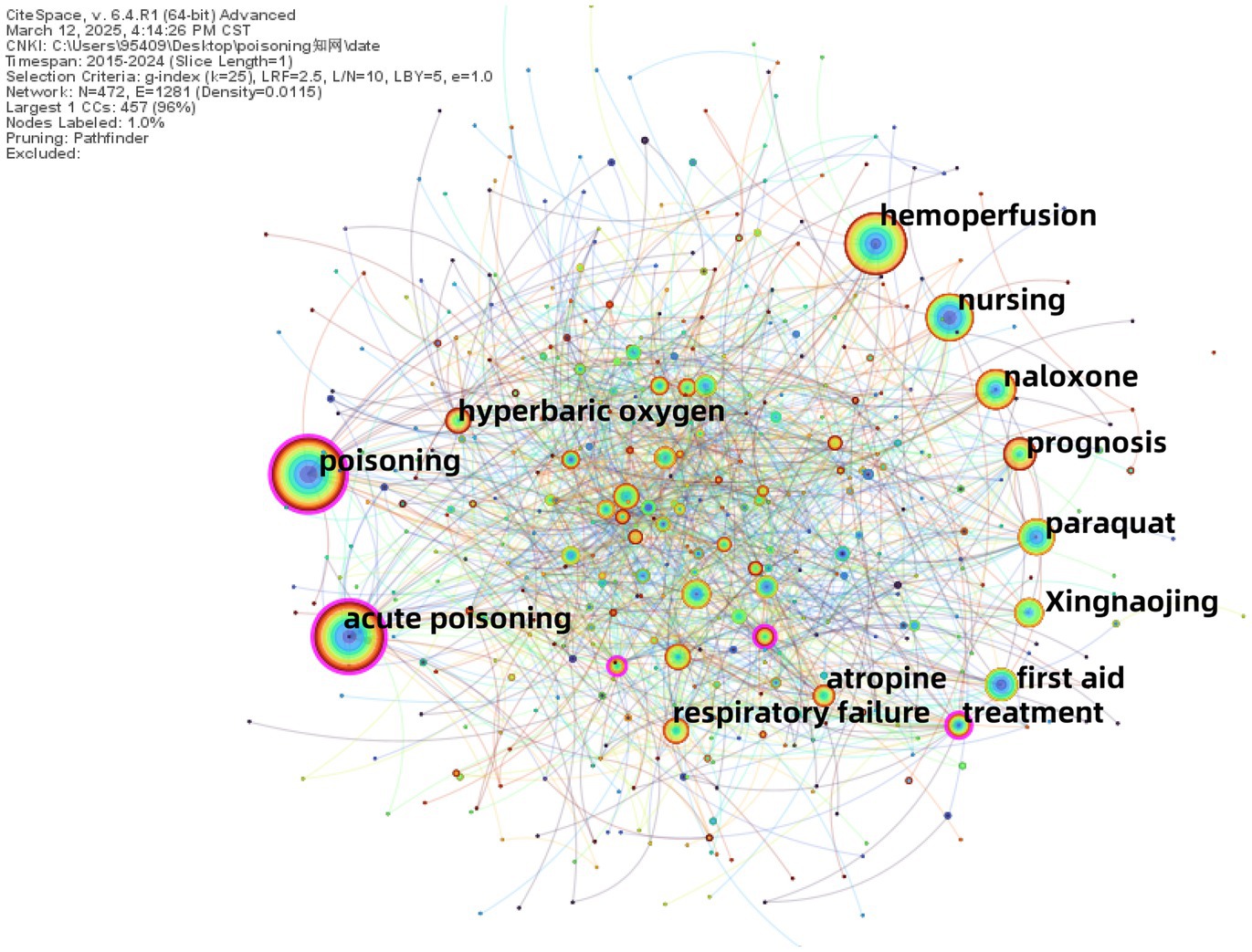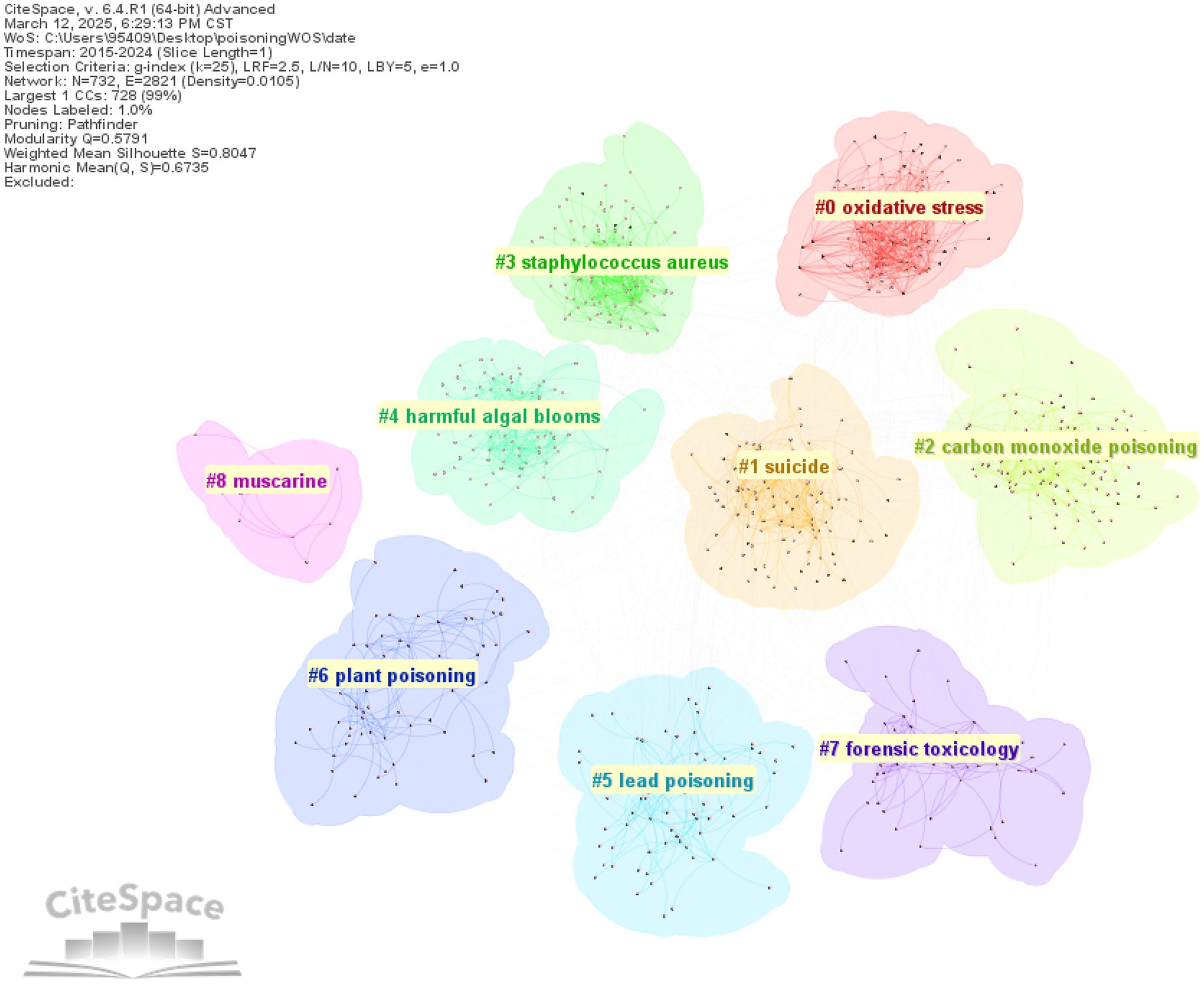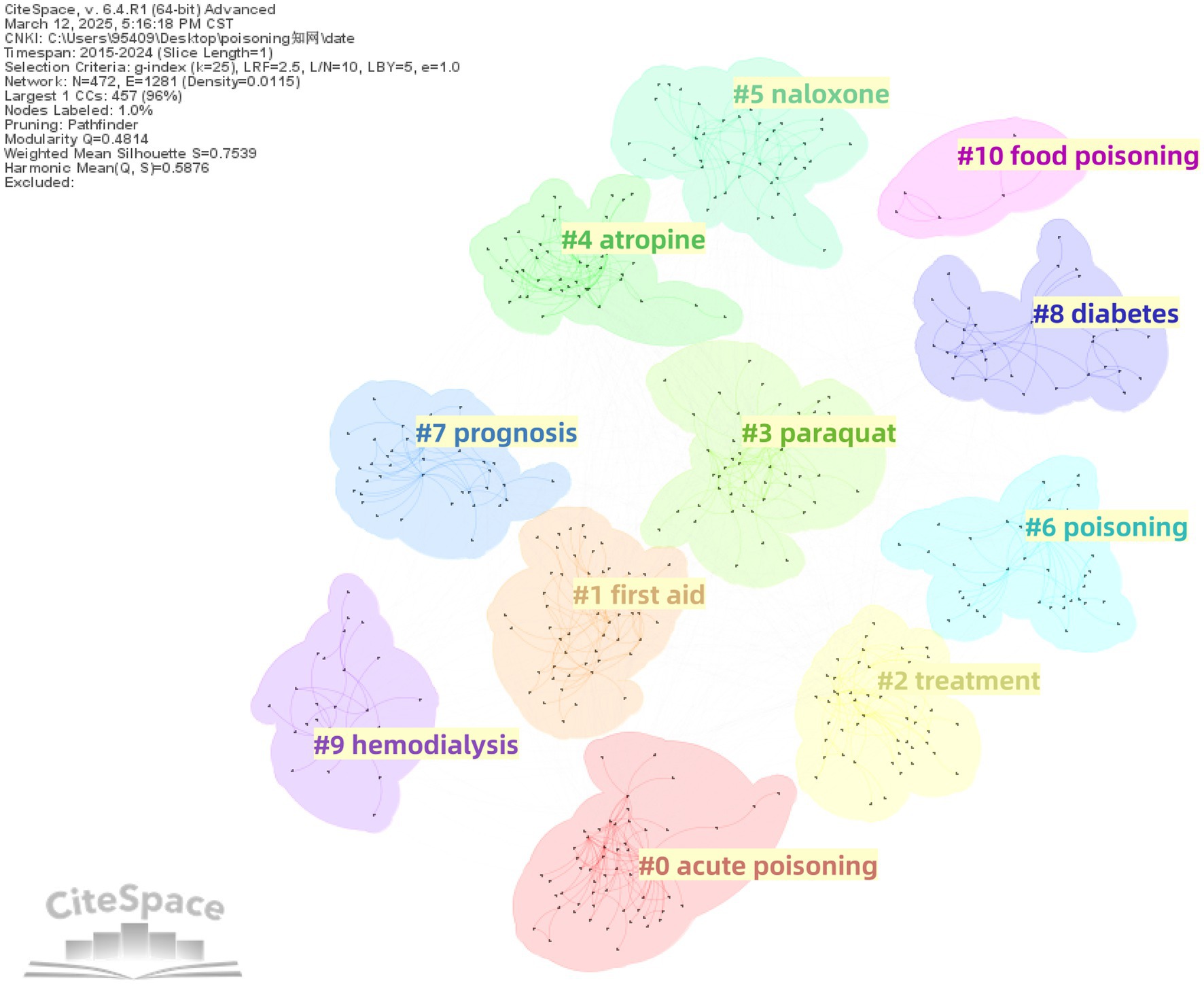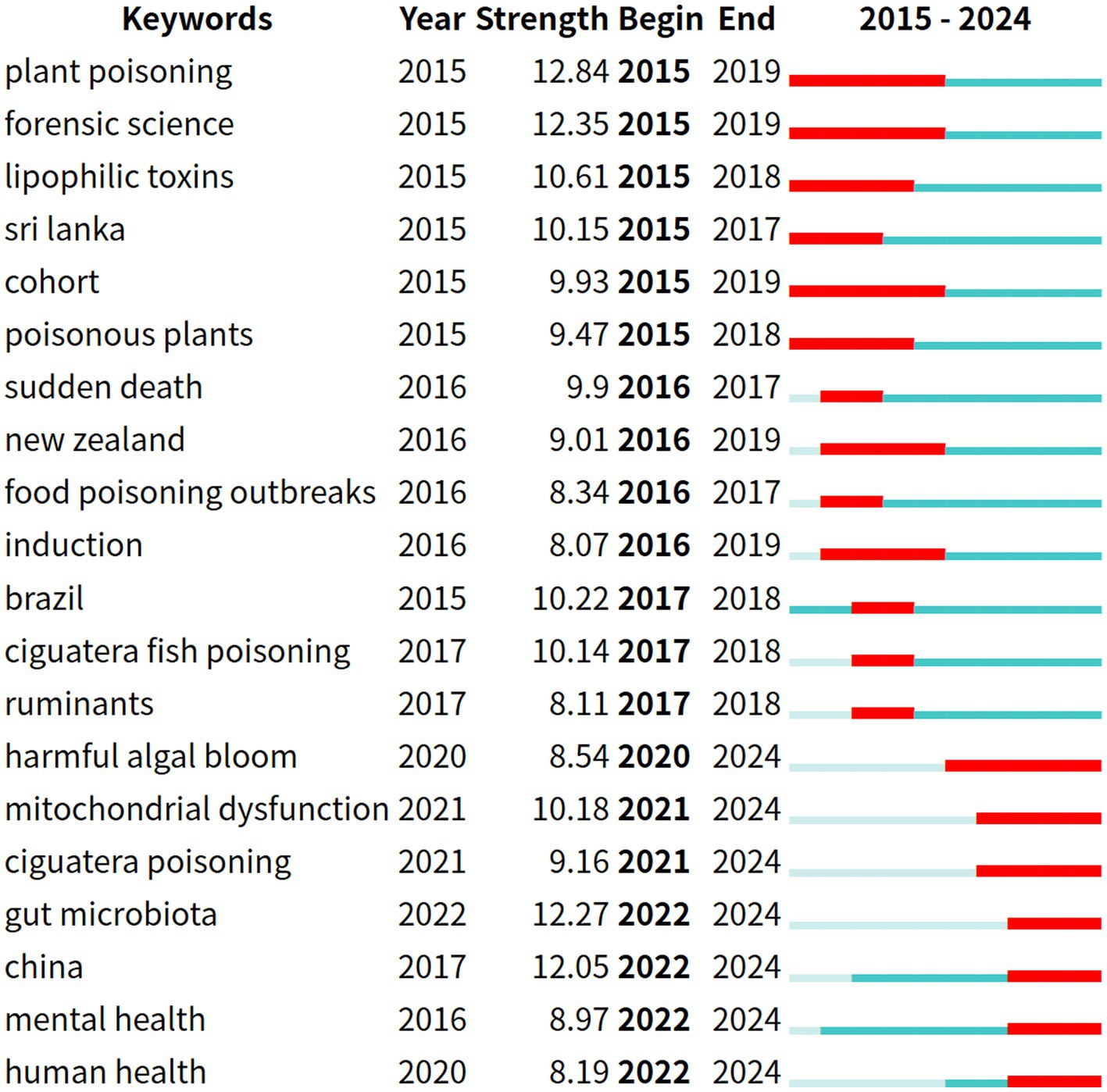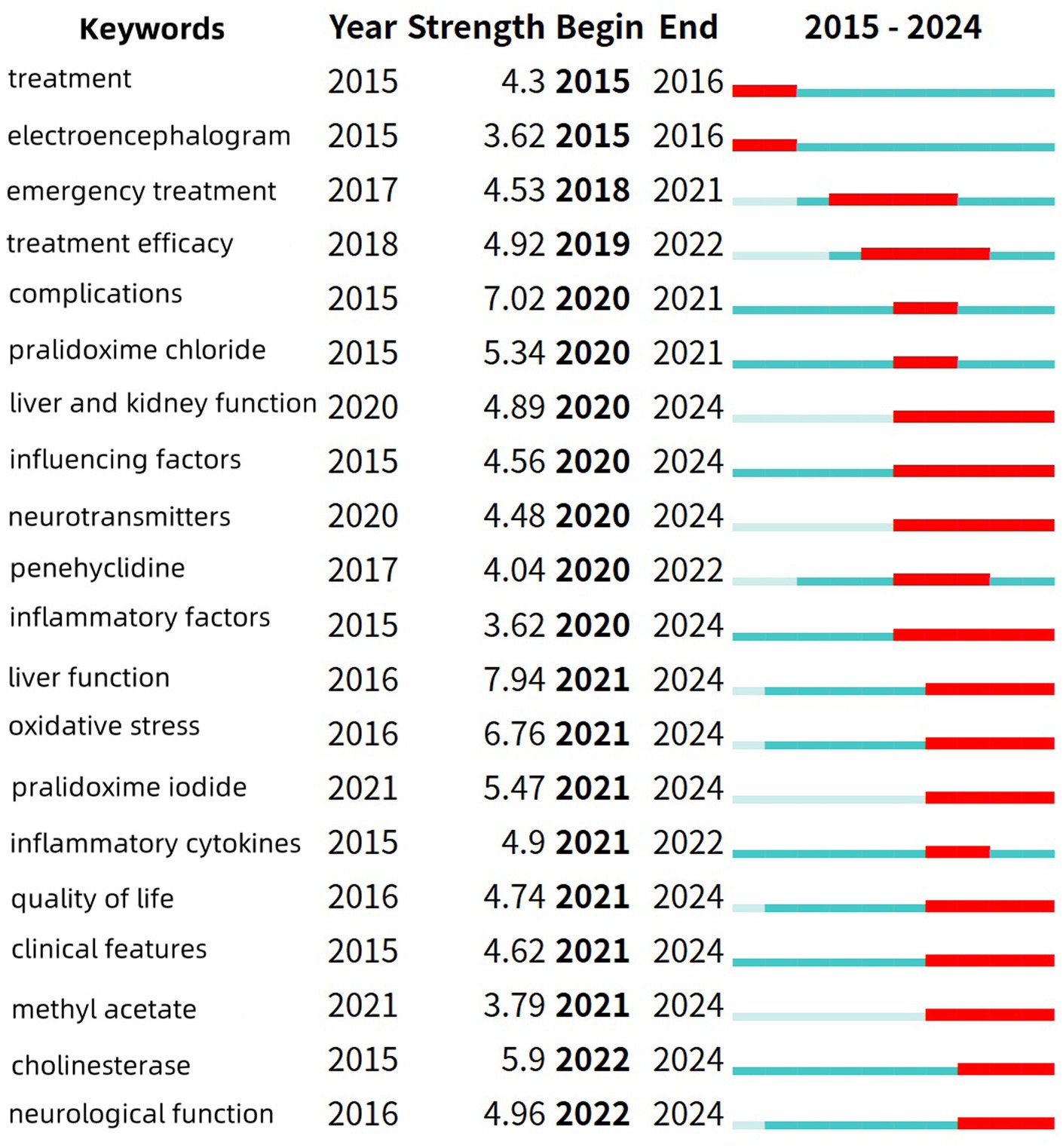- West China School of Public Health and West China Fourth Hospital, Sichuan University, Chengdu, China
Objective: Summarize the current status, hotspots, and frontier trends in poisoning research over the past decade using CiteSpace software, and provide direction for future research in toxicology and public health.
Methods: Relevant literature published between 2015 and 2024 was retrieved from the China National Knowledge Infrastructure (CNKI) and Web of Science Core Collection. CiteSpace software was employed to conduct a visual analysis of poisoning-related research literature from the past decade.
Results: A total of 5,644 Chinese articles and 14,985 English articles were included. High-frequency keywords in Chinese literature included “hemoperfusion” and “nursing” while high-frequency keywords in English literature included “exposure” “oxidative stress” and “identification.” Keywords with strong betweenness centrality included “treatment,” “blood purification” and “carbon monoxide.” Recent emerging hotspots in Chinese literature were “liver function” and “oxidative stress” while in English literature, “gut microbiota” has recently gained attention.
Conclusion: Poisoning-related research has shown an overall upward trend. The research hotspots in this field primarily include epidemiology, oxidative stress, clinical treatment, prognosis, and chemical substances (e.g., CO, paraquat). In-depth studies on gut microbiota and oxidative stress are expected to become future research trends in this field.
1 Introduction
Poisoning is one of the significant causes of morbidity and mortality worldwide (1), with its etiology being complex and multifaceted, involving exposure to a variety of substances. According to The Lancet Global Burden of Disease Study (GBD 2019), poisoning caused hundreds of thousands of deaths worldwide in 2019 (including both intentional and unintentional poisoning), with developing countries accounting for over 70% of these fatalities (2). The global medical community places high importance on poisoning prevention and treatment. Leading authorities such as the American Association of Poison Control Centers (AAPCC) and the European Association of Poisons Centers and Clinical Toxicologists (EAPCCT) have established multiple clinical management guidelines, emphasizing the importance of early identification, precise intervention, and standardized treatment.
Substances that cause poisoning include pharmaceuticals [such as barbiturates (3)], chemicals (such as industrial chemicals, pesticides, and household cleaners) (4), as well as natural toxins derived from plants and animals (such as toxic mushrooms and snake venoms) (5). Based on the duration and nature of exposure, poisoning can be classified into acute poisoning (short-term exposure to high doses of toxic substances), chronic poisoning (long-term exposure to low doses of toxic substances), and subacute poisoning (repeated or continuous exposure to moderate doses of toxic substances over a relatively short period). The causes of poisoning may be intentional (such as suicide or poisoning) (6) or accidental (such as occupational exposure or ingestion) (7).
With the acceleration of industrialization, a large number of new chemicals have been widely applied in industrial production, agriculture, medicine, and daily life. While the extensive use of these chemicals has driven social progress, it has also significantly increased human exposure to toxic substances, posing potential health and environmental risks. For instance, heavy metal pollution in industrial wastewater, pesticide residues threatening food safety (8), and the improper use of chemicals in daily life can all serve as triggers for poisoning incidents. Currently, there is a lack of systematic bibliometric research in the field of poisoning on a global scale, resulting in an incomplete understanding of research trends, knowledge structures, and regional contributions in this domain. Although existing international consensus frameworks, such as the Globally Harmonized System of Classification and Labeling of Chemicals (GHS), provide a classification system for toxic substances, quantitative analysis of research trends remains insufficient. Therefore, it is necessary to utilize CiteSpace to conduct a visual analysis of research related to poisoning, in order to identify current research hotspots and frontier trends.
Bibliometrics is a method of objectively evaluating the development status and trends of a research field through quantitative analysis of literature. CiteSpace is a Java-based network application primarily used for data analysis and visualization research. As a representative tool in the field of information visualization analysis, its unique functionalities play an important role in academia (9).
This study innovatively employs bibliometric methods to conduct a comprehensive analysis of global poisoning-related research, systematically reviewing the current international research landscape while specifically exploring the contributions and evolving trends of Chinese-language literature in this field. This study employs CiteSpace 6.4.R1 software to conduct visual analysis of literature in the field of poisoning, aiming to comprehensively understand the research status of poisoning over the past decade, identify key research priorities and directions, capture frontier trends, and promote global academic exchange and collaboration in poisoning research.
2 Data and methods
2.1 Data sources
China National Knowledge Infrastructure (CNKI) is the most influential comprehensive academic resource platform in China. To ensure the comprehensiveness and representativeness of research data, we used the CNKI database as our retrieval source, with the search scope limited to academic journals. Advanced search was employed with all journal types selected, covering the time period from 2015 to 2024.
Web of Science (WoS) is one of the world’s most authoritative academic research platforms, encompassing high-quality literature resources from internationally renowned publishers. To ensure the authority and representativeness of the research data, this study selected the Web of Science Core Collection (WoSCC) as the primary data source, with the citation index set to Science Citation Index Expanded (SCI-Expanded). The exact match search option was enabled, covering the time period from 2015 to 2024.
To ensure comprehensive literature coverage, the search strategy was designed as follows: Chinese search formula: (poisoning OR Acute poisoning OR Chronic poisoning). English search formula: (poisoning OR toxicosis OR Acute poisoning OR Chronic poisoning OR Acute toxicosis OR Chronic toxicosis).
2.2 Inclusion and exclusion criteria
The literature screening followed a two-stage process. First, articles were excluded based on titles/abstracts if irrelevant or incomplete. Second, full texts were assessed against predefined criteria. Two researchers independently conducted screening, with disagreements resolved through discussion or third-party arbitration, ensuring rigorous selection. Inclusion criteria: Academic journal literature focusing on poisoning published between 2015 and 2024. Exclusion criteria: (1) Literature without authors; (2) Incomplete information; (3) Invalid literature types such as conference papers, notices, news, speeches, etc.; (4) Literature irrelevant to the research topic (Figure 1).
2.3 Methods
The search results from the WOS database were exported in plain text format with “Full Record and Cited References,” while those from the CNKI database were exported in “Refworks” format and saved under the filename “download_.” The data were then analyzed using CiteSpace 6.4.R1. Parameter settings: The time span for both Chinese and English literature was set from 2015 to 2024, with time slices set to 1 year, threshold set to Top 50, and network pruning methods set to Pathfinder and Pruning sliced networks. All other settings were kept as system defaults. Conduct author analysis, institutional distribution mapping, country/region distribution analysis, keyword co-occurrence examination, clustering and burst detection analyses, and generate knowledge mapping visualizations.
3 Results
3.1 Annual publication volume
A total of 6,324 relevant articles were retrieved from the CNKI database, and 28,044 relevant articles were retrieved from the WOS database. After excluding non-compliant literature, 5,644 Chinese articles (effective literature inclusion rate: 89.24%) and 14,985 English articles (effective literature inclusion rate: 53.43%) were finally included. The number of English publications has gradually increased since 2015, reaching a peak in 2022, showing an overall upward trend. In contrast, the number of Chinese publications has gradually declined since 2015, reaching its lowest point in 2024, showing an overall downward trend. Additionally, the annual number of English publications consistently exceeded that of Chinese publications. This trend demonstrates the accelerating internationalization of poisoning research. The growth in English-language publications reflects dynamic global developments in toxicology, clinical poisoning treatment, and environmental toxin studies, with researchers increasingly favoring international journals to facilitate cross-border collaboration. The comprehensive coverage of English databases (e.g., Web of Science) and the dominant role of SCI/SSCI journals in research evaluation have further reinforced this trend (Figure 2).
3.2 Author analysis
The study incorporated a total of 684 authors from WOS and 525 authors from CNKI. In the author collaboration network visualization, each node represents an individual author, with node size and color saturation directly proportional to publication output. The connecting lines between nodes indicate collaborative relationships, where line thickness corresponds to collaboration strength and color denotes the year of cooperation. Clusters of densely interconnected nodes reveal established research teams within the network. This comprehensive visualization effectively demonstrates multidimensional research characteristics including individual productivity, collaboration intensity, and team structure.
Authors with the highest publication output were identified as core researchers in this field. Table 1 presents the top 10 most prolific authors. The leading contributors in English literature were Buckley, Nicholas A (73 publications), Eddleston, Michael (71), and Riet-correa, Franklin (57), while Weizhan Wang (40 publications), Xiangdong Jian (28), and Jing Li (20) ranked highest in Chinese literature. Notably, Buckley, Nicholas A and Eddleston, Michael in the English dataset, along with Weizhan Wang and Zhongqiu Lu in the Chinese dataset, maintained extensive collaboration networks, each forming a distinct research cluster centered around their work (Figures 3, 4).
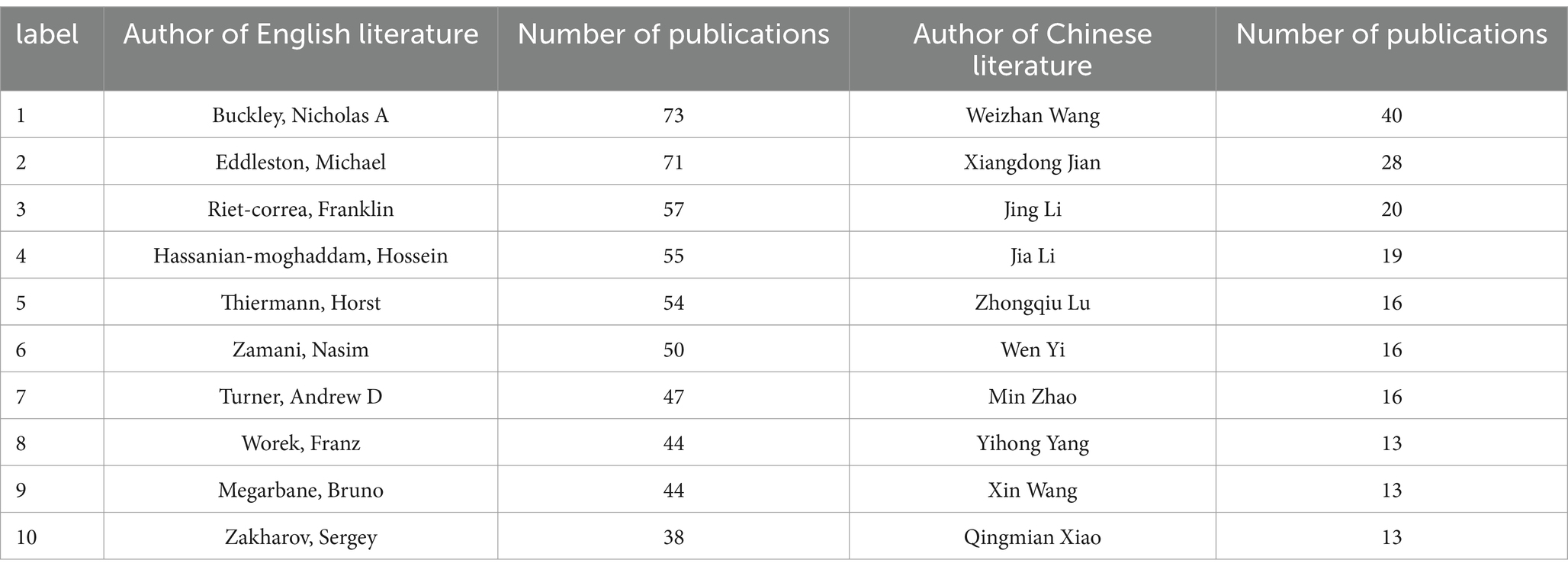
Table 1. Top 10 authors by publication volume in Chinese and English literature in toxicology research.
3.3 Institutional analysis
The study conducted a visualization analysis with “institution” as the node type. Table 2 presents the top 10 most productive research institutions. In English literature, the University of California System leads poisoning research with 276 high-quality publications, followed closely by the Egyptian Knowledge Bank (EKB) (220 publications) and Institut National de la Santé et de la Recherche Médicale (Inserm) (217 publications), demonstrating their significant academic influence in this field (Figure 5).
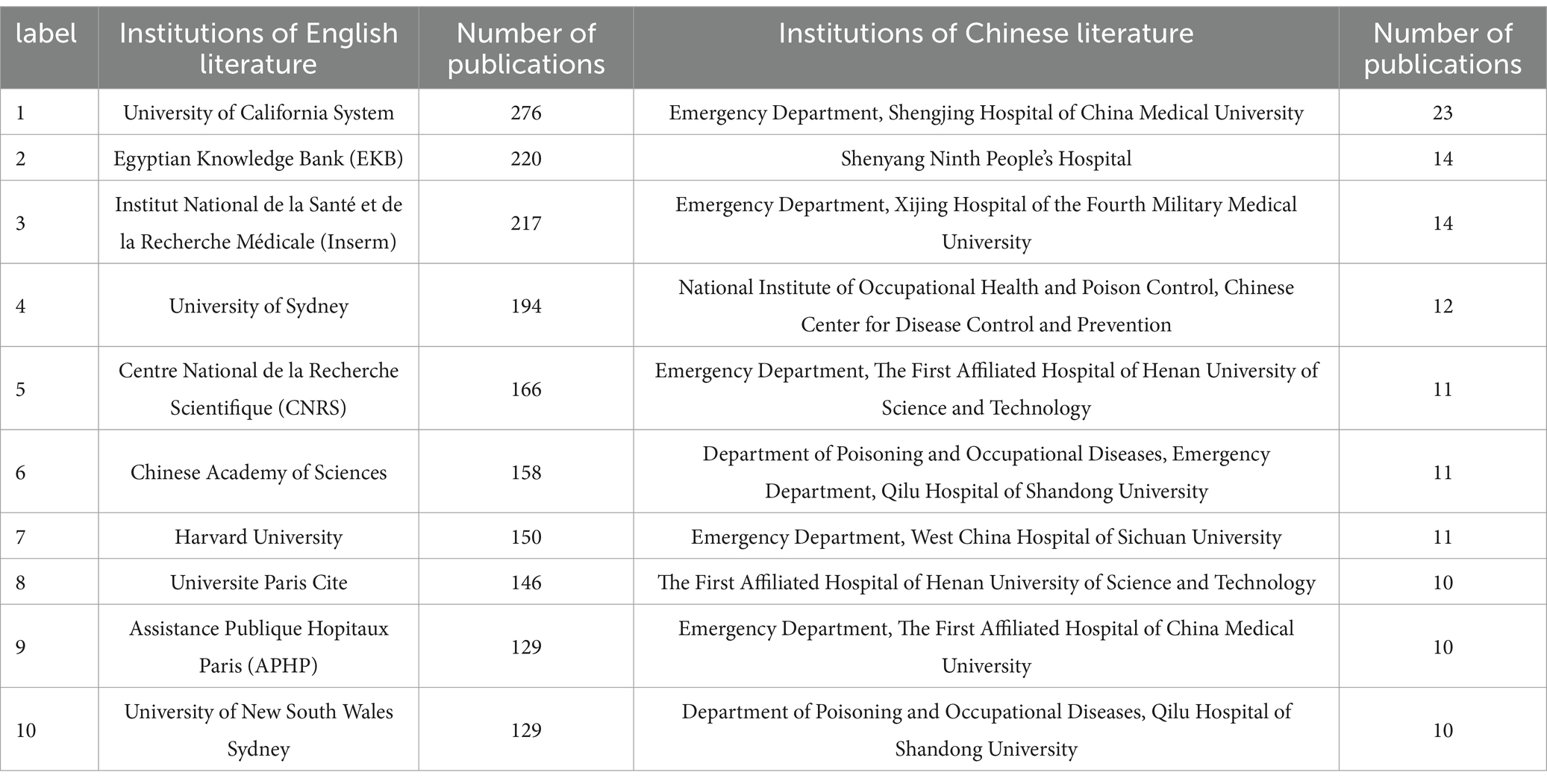
Table 2. Top 10 institutions by publication volume in Chinese and English literature in toxicology research.
For Chinese literature, the Emergency Department at Shengjing Hospital of China Medical University ranked first with 23 publications. Notably, the Emergency Physicians Branch of the Chinese Medical Doctor Association serves as a central hub in the collaboration network, maintaining strong research partnerships with institutions including The First Affiliated Hospital of Nanjing Medical University and the Chinese Center for Disease Control and Prevention (Figure 6).
3.4 Country/region analysis
The bibliometric analysis based on the Web of Science (WOS) database revealed the top 10 most productive countries/regions in poisoning research, as presented in Table 3. China ranked first with 3,138 publications, followed by the United States (2,764) and Japan (771). Notably, China and the U.S. demonstrated a substantial lead in publication output, creating a significant gap with other countries. This prominent advantage strongly reflects both nations’ strategic emphasis and sustained investment in poisoning research.
Through the visualized analysis of international collaboration networks (Figure 7), we can directly observe the characteristics of global scientific cooperation in this field. In the knowledge mapping representation, the size of each node (country) is proportional to its research output volume, while connecting lines indicate active research collaborations between nations. Notably, France, the United Kingdom, Spain and Canada have formed a relatively dense collaborative network with other countries, demonstrating particularly strong international research cooperation capabilities.
3.5 Keywords
3.5.1 Co-occurrence analysis
Keywords in co-occurrence analysis can effectively reflect the research hotspots in a specific field (10). High-frequency and high-centrality keywords often indicate popular research topics within the domain. Excluding keywords related to the search terms such as “poisoning” “acute poisoning” and “toxicity” the high-frequency keywords in Chinese literature include “hemoperfusion” “nursing” “naloxone” “prognosis” and “paraquat” etc. In English literature high-frequency keywords include “exposure” “oxidative stress” “identification” “management” and “mortality” etc. In the Chinese literature keywords with a centrality > 0.1 indicate strong betweenness centrality and these keywords (“treatment” (centrality = 0.12) “blood purification” (centrality = 0.12) and “carbon monoxide” (centrality = 0.11)) represent research hotspots in the field (Table 4).
Co-occurrence analysis maps were generated, where nodes represent keywords, node size indicates the frequency of keywords, different colors represent the years in which the keywords appeared, and connecting lines between nodes indicate relationships between keywords (Figures 8, 9).
3.5.2 Cluster analysis
Keyword clustering involves grouping and clustering terms with similar or identical themes reflecting the composition of research topics within a field. The modularity value Q (>0.3 indicates a significant cluster structure) and the mean silhouette value S (>0.5 indicates reasonable clustering >0.7 indicates highly efficient and convincing clustering) were used as evaluation metrics. This study employed K-core clustering for analysis.
For English literature, a total of 9 clusters were obtained, with Q = 0.5791 (>0.3) and S = 0.8047 (>0.7), indicating a significant and credible cluster structure. The clustering results were as follows: #0 oxidative stress, #1 suicide, #2 carbon monoxide poisoning, #3 staphylococcus, #4 harmful algal blooms, #5 lead poisoning, #6 plant poisoning, #7 forensic toxicology, and #8 muscarine (Figure 10).
For Chinese literature, a total of 11 clusters were obtained, with Q = 0.4814 (>0.3) and S = 0.7539 (>0.7), indicating a significant and credible cluster structure. The clustering results were as follows: #0 acute poisoning, #1 first aid, #2 treatment, #3 paraquat, #4 atropine, #5 naloxone, #6 poisoning, #7 prognosis, #8 diabetes, #9 hemodialysis, and #10 food poisoning (Figure 11).
The emergence of these clusters can be attributed to research trends. For example, the forensic toxicology cluster (English #7) likely reflects the international academic focus on toxicological investigations in legal and criminal contexts, such as postmortem toxin analysis and drug-related fatalities. Similarly, the staphylococcus cluster (English #3) may represent studies on bacterial toxins (e.g., staphylococcal enterotoxins) and their role in foodborne illnesses. In contrast, Chinese literature places greater emphasis on clinical toxicology, particularly regarding acute poisoning (e.g., paraquat, #3) and antidote applications (e.g., atropine for organophosphate poisoning, #4; naloxone for opioid overdose, #5).
3.5.3 Burst analysis
Burst terms refer to key terms that exhibit significant frequency fluctuations within specific time intervals, and their distribution characteristics can effectively reflect the dynamic evolution of academic research hotspots. In the keyword burst analysis map, the blue line represents the time interval, while the red line indicates the period during which the usage of the keyword significantly increased. “Year” denotes the earliest year the keyword appeared, “Strength” represents the burst strength, and “Begin” and “End” indicate the start and end times of the keyword’s burst, respectively (Figures 12, 13).
The top 20 burst terms were selected for both Chinese and English literature. Among the English literature, the terms with the highest burst strength include “plant poisoning,” “forensic science” and “gut microbiota.” The term that has recently become a hotspot is “gut microbiota.” In the Chinese literature, the terms with the highest burst strength are “liver function,” “complications” and “oxidative stress.” The terms that have recently become hotspots are “liver function” and “oxidative stress.”
4 Discussion
4.1 Shared research hotspots
Based on a comprehensive analysis of high-frequency keywords, high-betweenness centrality keywords, and cluster analysis, carbon monoxide (CO) emerges as a common research hotspot in both Chinese and English literature. This phenomenon is likely closely related to the prevalence and severity of carbon monoxide poisoning worldwide. CO is an inorganic compound gas that is colorless, odorless, and highly toxic. When inhaled in large quantities, CO rapidly binds to hemoglobin, disrupting the normal transport and supply of oxygen. This often leads to severe damage to the central nervous and cardiovascular systems, causing a range of pathological changes. Survivors of severe poisoning frequently suffer from significant neurological sequelae, such as mental abnormalities, Parkinson’s syndrome, or complications like delayed encephalopathy (11, 12).
4.2 Divergent research focuses
Although preventive interventions (such as public education and safety measures) have significantly reduced the incidence of poisoning, as a common clinical type of poisoning, the optimization of treatment protocols remains a critical issue to be addressed. Research trends indicate that innovative treatment strategies primarily focus on two directions: first, non-pharmacological interventions based on physical principles aimed at accelerating the dissociation of CO-hemoglobin complexes; and second, the development of portable emergency medications, particularly molecular agents with high-efficiency CO clearance capabilities, to enable immediate on-site treatment of poisoning (13).
English literature tends to focus more on epidemiological and molecular-level studies of poisoning. This inclination is reflected in high-frequency keywords such as “identification,” “prevalence,” “risk factors,” “exposure” and “oxidative stress.”
Firstly, in terms of epidemiological research, scholars have focused on the temporal and regional distribution patterns of poisoning incidents and population characteristics, such as in Egypt, Iran, and the United States. Each country has its unique research focus. For example, Egypt has conducted epidemiological surveys on acute poisoning among children visiting treatment centers (14), Iran has performed retrospective analyses of buprenorphine abuse (15), and the United States has conducted descriptive epidemiological analyses of occupational poisoning (16). The appearance of the high-frequency keyword “children” may reflect the international community’s heightened concern about poisoning incidents in vulnerable populations, particularly children, due to their physiological characteristics and sensitivity to environmental hazards (17, 18).
The in-depth analysis based on GBD 2019 data reveals significant geographical heterogeneity in the global burden of poisoning. Spatially, poisoning mortality rates in developing countries are 3.5 times higher than in high-income nations, with particularly striking disparities in Southeast Asia and Africa. These regions exhibit alarmingly high age-standardized mortality rates (ASMR) of 4.2 per 100,000 population from pesticide poisoning (e.g., organophosphates), substantially exceeding the global average of 1.8 per 100,000. These regional disparities primarily stem from gaps in the enforcement of agricultural chemical regulations, accessibility of primary emergency medical resources, and the reach of public health education programs. The GBD data identifies two key high-risk population groups: among 15–49 year-olds, suicide-related poisonings (e.g., paraquat, opioids) account for 42% of all poisoning deaths, while in low-income countries, accidental poisonings (e.g., ingestion of household cleaners or medications) constitute 28% of cases among children under five. These epidemiological patterns are corroborated by our keyword co-occurrence analysis, where high-frequency terms such as “exposure” and “risk factors” in English-language literature show strong alignment with the exposure patterns revealed in the GBD study (2).
Secondly, at the molecular level, English literature emphasizes the role of various toxins in inducing oxidative stress or the protective effects of antidotes through oxidative stress modulation. For instance, acute dichlorvos (DDVP) poisoning can significantly elevate blood glucose levels in broiler chickens, accompanied by an imbalance in redox homeostasis (19). The core toxic mechanism of acute CO poisoning stems from the excessive generation of reactive oxygen species (ROS) and reactive nitrogen species (RNS), leading to the collapse of the body’s antioxidant defense system (20). Additionally, in studies on methylmercury (MeHg) toxicity, ghrelin has been found to potentially exert neuroprotective effects by regulating oxidative stress pathways (21). Lastly, infections caused by Staphylococcus species, such as Staphylococcus aureus, are also a research hotspot.
Chinese literature primarily focuses on clinical treatment and prognosis in poisoning research. This is reflected in high-frequency keywords such as “hemoperfusion,” “nursing” and “prognosis” as well as high-betweenness centrality keywords like “treatment” and “blood purification,” along with cluster analysis results.
Blood purification plays a central role in poisoning treatment and is a critical method for managing severe poisoning cases. Hemoperfusion (HP) is a technique that involves circulating blood through an external adsorption device to directly remove toxins or metabolites using adsorbents such as activated charcoal or resin. It is particularly effective for toxins with high lipid solubility and protein binding rates, such as organophosphorus pesticides. HP can rapidly reduce toxin concentrations in the blood, mitigating damage to target organs. It is used for various drug poisonings (e.g., barbiturates, theophylline) and chemical poisonings (e.g., paraquat) (22–24).
The high-frequency keywords “prognosis” and “nursing” reflect the “patient-centered” service philosophy of the Chinese healthcare system. This characteristic highlights China’s focus not only on acute-phase rescue and treatment but also on long-term rehabilitation and quality-of-life improvement for patients. It also indicates a shift in China’s poisoning treatment field from solely treatment to comprehensive management.
4.3 Future research trajectories
The burst analysis results of Chinese literature indicate that liver function and oxidative stress are likely to become key research directions in China in the future.
It is noteworthy that these two research directions–liver function and oxidative stress–are closely interconnected. As the primary metabolic organ, the liver plays a crucial role in the occurrence and development of oxidative stress. Simultaneously, oxidative stress is one of the key mechanisms leading to liver function damage. Therefore, future research in China may increasingly focus on the intersection of these two areas.
The keyword burst analysis results for English literature reveal that the term with the highest burst strength over the past 3 years and ongoing research interest is “gut microbiota.” This suggests that gut microbiota may become an emerging research direction and hotspot in the field of poisoning research. The gut microbiota refers to the complex microbial community residing in the human digestive tract, comprising up to 10^14 microorganisms and over 1,000 different bacterial species, playing a vital role in maintaining human health. In poisoning research, the gut microbiota has demonstrated unique detoxification potential. For example, in heavy metal poisoning, Luo et al. found that microbial detoxification shows promise in treating subchronic arsenic poisoning (25). Wang et al. through animal experiments, discovered that intervening in the gut microbiota composition of manganese-exposed rats significantly improved their neuroinflammatory responses, opening new therapeutic avenues based on gut microbiota remodeling for manganese poisoning treatment (26).
However, current research on the role of gut microbiota in poisoning still faces several challenges. The specific molecular mechanisms by which the gut microbiota participates in detoxification remain incompletely understood. Although studies have shown that the gut microbiota can exert detoxification effects through metabolic transformation, competitive binding, immune regulation, and other pathways, the signaling pathways and key molecules involved in these processes require further clarification (27). Additionally, the long-term safety and efficacy of gut microbiota-based interventions, such as probiotic supplementation (28) and fecal microbiota transplantation (29), need more clinical data to support their application.
4.4 Strengths and limitations
This study represents the first global bibliometric analysis of poisoning research employing CiteSpace visualization technology. By systematically collecting high-quality literature data from both the Web of Science and CNKI databases, we ensured sufficient sample size and representativeness, thereby enhancing the scientific validity and reliability of our findings. However, it should be noted that the exclusion of databases such as PubMed and Wanfang may limit coverage of certain regional or specialized research outputs. Future studies could expand data sources and employ cross-validation across multiple databases to further improve the comprehensiveness and accuracy of research conclusions.
5 Conclusion
In recent years, research related to poisoning has shown an overall upward trend. Currently, the main research hotspots in this field include epidemiology, molecular-level studies (such as oxidative stress), clinical treatment (e.g., blood purification), prognosis, and chemical substances (e.g., CO, paraquat). Research on gut microbiota in the field of poisoning may become a new breakthrough, as its role in toxin metabolism, detoxification mechanisms, and individual susceptibility holds promise for providing new insights into the prevention and treatment of poisoning. Meanwhile, studies on the molecular mechanisms of oxidative stress will continue to deepen, potentially revealing new therapeutic targets in the future.
Author contributions
WZ: Writing – review & editing, Data curation, Writing – original draft. YX: Writing – review & editing. LX: Funding acquisition, Writing – review & editing.
Funding
The author(s) declare that financial support was received for the research and/or publication of this article. This study was supported by Sichuan Provincial Administration of Traditional Chinese Medicine (No. 2024MS084) and Science and Technology Department of Tibet (No. XZ202201ZY0033G).
Acknowledgments
We would like to express gratitude to CM Chen, who invented CiteSpace, which is free to use.
Conflict of interest
The authors declare that the research was conducted in the absence of any commercial or financial relationships that could be construed as a potential conflict of interest.
Generative AI statement
The authors declare that no Gen AI was used in the creation of this manuscript.
Publisher’s note
All claims expressed in this article are solely those of the authors and do not necessarily represent those of their affiliated organizations, or those of the publisher, the editors and the reviewers. Any product that may be evaluated in this article, or claim that may be made by its manufacturer, is not guaranteed or endorsed by the publisher.
Supplementary material
The Supplementary material for this article can be found online at: https://www.frontiersin.org/articles/10.3389/fpubh.2025.1592916/full#supplementary-material
References
1. Ghannoum, M, and Roberts, DM. Management of poisonings and intoxications. Clin J Am Soc Nephrol. (2023) 18:1210–21. doi: 10.2215/CJN.0000000000000057
2. GBD 2019 Risk Factors Collaborators. Global burden of 87 risk factors in 204 countries and territories, 1990-2019: a systematic analysis for the global burden of disease study 2019. Lancet. (2020) 396:1223–49. doi: 10.1016/S0140-6736(20)30752-2
3. Peshin, SS, and Gupta, YK. Poisoning due to household products: a ten years retrospective analysis of telephone calls to the National Poisons Information Centre, all India Institute of Medical Sciences, New Delhi, India. J Forensic Leg Med. (2018) 58:205–11. doi: 10.1016/j.jflm.2018.07.005
4. Fletcher, MT, and Netzel, G. Food safety and natural toxins. Toxins. (2020) 12:236. doi: 10.3390/toxins12040236
5. Apata, J, Pennap, D, Ma, Y, and Mosholder, A. Suicide poisoning mortality: a comparison of the national poison data system and centers for disease control national dataset. Inj Prev. (2024) 30:81–3. doi: 10.1136/ip-2023-044940
6. Martins, C, Viegas, C, Eriksen, E, Graff, P, Afanou, AK, Straumfors, A, et al. Unraveling the occupational exposure to mycotoxins in a waste management setting: results from a case study in Norway. Front Public Health. (2025) 13:1536836. doi: 10.3389/fpubh.2025.1536836
7. Saravanan, A, Kumar, PS, Duc, PA, and Rangasamy, G. Strategies for microbial bioremediation of environmental pollutants from industrial wastewater: a sustainable approach. Chemosphere. (2023) 313:137323. doi: 10.1016/j.chemosphere.2022.137323
8. Chen, C. Searching for intellectual turning points: progressive knowledge domain visualization. Proc Natl Acad Sci USA. (2004) 101:5303–10. doi: 10.1073/pnas.0307513100
9. Luo, H, Cai, Z, Huang, Y, Song, J, Ma, Q, Yang, X, et al. Study on pain catastrophizing from 2010 to 2020: a bibliometric analysis via CiteSpace. Front Psychol. (2021) 12:759347. doi: 10.3389/fpsyg.2021.759347
10. Adach, W, Błaszczyk, M, and Olas, B. Carbon monoxide and its donors - chemical and biological properties. Chem Biol Interact. (2020) 318:108973. doi: 10.1016/j.cbi.2020.108973
11. Jia, Y, Han, N, Guo, H, Li, H, Du, Y, Li, C, et al. Hyperbaric oxygen therapy for acute carbon monoxide poisoning patients with coma onset. Eur J Med Res. (2025) 30:125. doi: 10.1186/s40001-025-02387-9
12. Rose, JJ, Wang, L, Xu, Q, McTiernan, CF, Shiva, S, Tejero, J, et al. Carbon monoxide poisoning: pathogenesis, management, and future directions of therapy. Am J Respir Crit Care Med. (2017) 195:596–606. doi: 10.1164/rccm.201606-1275CI
13. Azab, SMS, Hirshon, JM, Hayes, BD, El-Setouhy, M, Smith, GS, Sakr, ML, et al. Epidemiology of acute poisoning in children presenting to the poisoning treatment center at Ain Shams University in Cairo, Egypt, 2009-2013. Clin Toxicol. (2016) 54:20–6. doi: 10.3109/15563650.2015.1112014
14. Ansari, M, Rostam-Abadi, Y, Baheshmat, S, Hamzehzadeh, M, Gholami, J, Mojtabai, R, et al. Buprenorphine abuse and health risks in Iran: a systematic review. Drug Alcohol Depend. (2021) 226:108871. doi: 10.1016/j.drugalcdep.2021.108871
15. Downs, JW, Wills, BK, Cumpston, KL, and Rose, SR. Descriptive epidemiology of clinically significant occupational poisonings, United States, 2008-2018. Clin Toxicol. (2021) 59:1259–63. doi: 10.1080/15563650.2021.1892717
16. Gaw, CE, Lim, CG, Korenoski, AS, and Osterhoudt, KC. Beverage ethanol exposures among infants reported to United States poison control centers. Clin Toxicol. (2021) 59:619–27. doi: 10.1080/15563650.2020.1843660
17. Land, ME, Wetzel, M, Geller, RJ, Kamat, PP, and Grunwell, JR. Analysis of 207,543 children with acute opioid poisonings from the United States National Poison Data System. Clin Toxicol. (2020) 58:829–36. doi: 10.1080/15563650.2019.1691731
18. Huang, L, Guo, X, Liu, P, Zhao, Y, Wu, C, Zhou, C, et al. Correlation between acute brain injury and brain metabonomics in dichlorvos-poisoned broilers. J Hazard Mater. (2022) 422:126849. doi: 10.1016/j.jhazmat.2021.126849
19. Coburn, RF. Carbon monoxide (CO), nitric oxide, and hydrogen sulfide signaling during acute CO poisoning. Front Pharmacol. (2021) 12:830241. doi: 10.3389/fphar.2021.830241
20. Ferrer, B, Suresh, H, Tinkov, AA, Santamaria, A, Rocha, JB, Skalny, AV, et al. Ghrelin attenuates methylmercury-induced oxidative stress in neuronal cells. Mol Neurobiol. (2022) 59:2098–115. doi: 10.1007/s12035-022-02726-5
21. Ronco, C, and Bellomo, R. Hemoperfusion: technical aspects and state of the art. Crit Care. (2022) 26:135. doi: 10.1186/s13054-022-04009-w
22. Xiao, Q, Wang, W, Qi, H, Gao, X, Zhu, B, Li, J, et al. Continuous hemoperfusion relieves pulmonary fibrosis in patients with acute mild and moderate paraquat poisoning. J Toxicol Sci. (2020) 45:611–7. doi: 10.2131/jts.45.611
23. Yu, G, Li, Y, Jian, T, Shi, L, Cui, S, Zhao, L, et al. Clinical analysis of acute organophosphorus pesticide poisoning and successful cardiopulmonary resuscitation: a case series. Front Public Health. (2022) 10:866376. doi: 10.3389/fpubh.2022.866376
24. Luo, Y, Wang, J, Wang, C, Wang, D, Li, C, Zhang, B, et al. The fecal arsenic excretion, tissue arsenic accumulation, and metabolomics analysis in sub-chronic arsenic-exposed mice after in situ arsenic-induced fecal microbiota transplantation. Sci Total Environ. (2023) 854:158583. doi: 10.1016/j.scitotenv.2022.158583
25. Wang, H, Yang, F, Xin, R, Cui, D, He, J, Zhang, S, et al. The gut microbiota attenuate neuroinflammation in manganese exposure by inhibiting cerebral NLRP3 inflammasome. Biomed Pharmacother. (2020) 129:110449. doi: 10.1016/j.biopha.2020.110449
26. Kaur, R, and Rawal, R. Influence of heavy metal exposure on gut microbiota: recent advances. J Biochem Mol Toxicol. (2023) 37:e23485. doi: 10.1002/jbt.23485
27. Karakula-Juchnowicz, H, Rog, J, Juchnowicz, D, Łoniewski, I, Skonieczna-Żydecka, K, Krukow, P, et al. The study evaluating the effect of probiotic supplementation on the mental status, inflammation, and intestinal barrier in major depressive disorder patients using gluten-free or gluten-containing diet (SANGUT study): a 12-week, randomized, double-blind, and placebo-controlled clinical study protocol. Nutr J. (2019) 18:50. doi: 10.1186/s12937-019-0475-x
28. Porcari, S, Benech, N, Valles-Colomer, M, Segata, N, Gasbarrini, A, Cammarota, G, et al. Key determinants of success in fecal microbiota transplantation: from microbiome to clinic. Cell Host Microbe. (2023) 31:712–33. doi: 10.1016/j.chom.2023.03.020
Keywords: CiteSpace, poisoning, visualization research, oxidative stress, gut microbiota
Citation: Zhu W, Xiao Y and Xie L (2025) Visualization analysis of poisoning-related research based on CiteSpace. Front. Public Health. 13:1592916. doi: 10.3389/fpubh.2025.1592916
Edited by:
Babak Pakbin, Texas A&M University, United StatesReviewed by:
Ruikai Wu, First Affiliated Hospital of Xinjiang Medical University, ChinaKatayoun Pahlavanyali, Texas A&M University, United States
Copyright © 2025 Zhu, Xiao and Xie. This is an open-access article distributed under the terms of the Creative Commons Attribution License (CC BY). The use, distribution or reproduction in other forums is permitted, provided the original author(s) and the copyright owner(s) are credited and that the original publication in this journal is cited, in accordance with accepted academic practice. No use, distribution or reproduction is permitted which does not comply with these terms.
*Correspondence: LinShen Xie, bGluc2hlbnhpZUAxNjMuY29t
 Wen Zhu
Wen Zhu Yao Xiao
Yao Xiao LinShen Xie
LinShen Xie